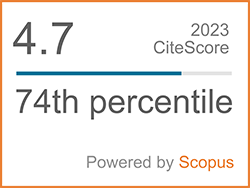The Roles of Plant Cell Wall as the First-line Protection Against Lead (Pb) Toxicity
Abstract
Heavy metal contamination is one of the serious environmental problems. Among heavy metals, lead (Pb) is a non-essential metal with highly toxic to plants and animals. Due to the high atomic weight, Pb is largely accumulated in plant roots more than shoots. Pb absorbed along with water and other nutrient possibly pass through cell wall and cell membrane. A number of plants have been accumulated Pb in their cell wall and intercellular space. This review paper focuses on the role of plant cell wall as the first line protection of the plant cells against Pb toxicity. Upon Pb exposure, production of Reactive Oxygen Species (ROS) such as nitric oxide (NO) and hydrogen peroxide (H2O2) have been increased. These small molecules are normally used as signaling molecules in antioxidation system activating radical scavengers e.g. peroxidase and catalase. Sharply increased ROS may also acts as a signal for remodifying cell wall structure. Pectins and other polysaccharides in plant cells can bind and sequester Pb within the cell walls. The thick cell walls act as a barrier that limit Pb from entering into the protoplasm as well as serving as a compartment for storing the metal.
Keywords
DOI: 10.14416/j.ijast.2018.09.003
Refbacks
- There are currently no refbacks.






.png)



